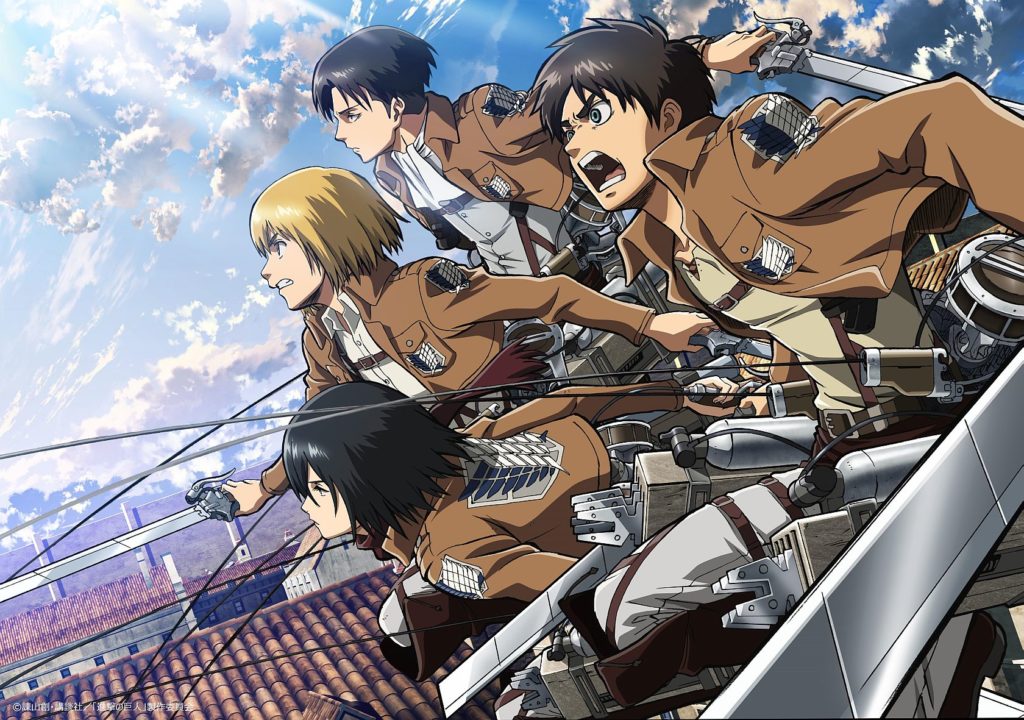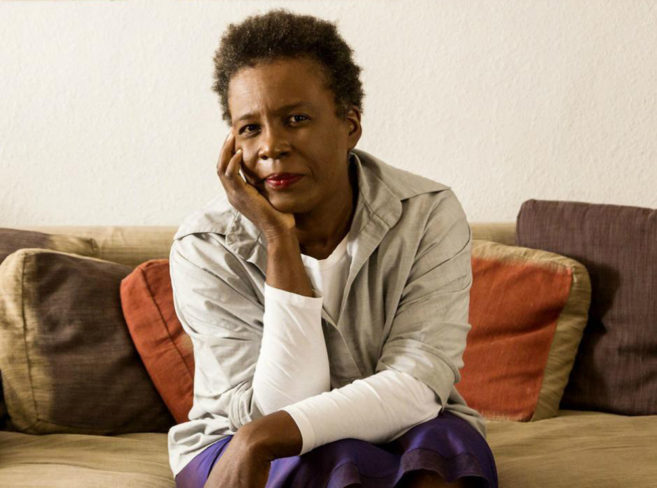Termed a “death opera” by director Joy Hui Lin in the Los Angeles Review of Books, the Japanese anime Attack on Titan is an extraordinary spectacle of violence that, in its searing depiction of on-screen death, blurs the distinctions between representation and reality.
Titans—giant, grotesque humanoids that kill and eat humans with impunity—have forced what’s left of humanity behind a set of three enormous 50-foot walls. As the walls are too large to be defended in their entirety, each wall has four “districts” that draw Titans towards them, allowing the military to repel them more easily. When Titans breach the outermost wall causing Titans to flood the interior, the human protagonist Eren is left with no choice but to flee and abandon his injured mother, watching in horror as she’s snapped in half and eaten by a grinning Titan. Suffering heavy losses, humanity is forced to retreat inside the second wall, abandoning the territory. Eren vows to destroy the Titans and joins the Survey Corps, the military force dedicated to reclaiming the land outside of the walls, one derided by society for its near-absolute casualty rate.
In Titan’s apocalyptic universe, death looms higher than the walls that keep it at bay. Characters die noble, brutal and meaningless deaths, often in the vain hope that their sacrifice is a significant contribution to the humanity’s future. Bodies are regularly shown crushed, half-consumed and mutilated beyond recognition with a steady, unflinching gaze. The foregrounding of these compromised bodies in Japanese animation—a tradition that, broadly, has tended away from graphic violence—resembles the violence against Black people as it has appeared in surveillance camera footage, live-streams and news coverage. Visual records of violence that, in previous decades, have been censored to the point of being inaccessible are now widely available in an unprecedented way. But the medium itself has always been articulated in terms of death.
The idea that death has an intractable relation to the image—and by extension, the filmic image—is not a new one. Laura Mulvey’s Death 24x a Second ruminates on film’s indexical relation to the past, suggesting that film acts as a record of the past and that in watching an old film, the viewer squares the knowledge of someone’s death with their role in the narrative, reducing the moving image to a series of stills, dead in the water. In Franceska Rouzard’s essay “Persistence of Vision,” she discusses the effect that live-broadcasted acts of violence—specifically, the Facebook Live broadcast of Philando Castile being shot by the police—have on the medium. “Live streaming collapses the distance between the viewer and the viewed, between the viewer and the event itself. We feel more directly involved, and more intensely helpless,” she writes. Claudia Rankine, speaking on Emmett Till’s mother’s decision to hold an open-casket funeral in “The State of Black Life is One of Mourning,” remarks, “[Mamie Till] Mobley’s refusal to keep private grief private allowed a body that meant nothing to the criminal-justice system to stand as evidence. By placing both herself and her son’s corpse in positions of refusal relative to the etiquette of grief, she ‘disidentified’ with the tradition of the lynched figure left out in public view as a warning to the black community, thereby using the lynching tradition against itself.”
For all of the turn-of-the-century hand-wringing over the effects that graphic, real or fictionalized violence would have on children and the psyche, the results of that violence pales in comparison to the collective trauma caused by the visual medium accommodating a broader spectrum of violence against Black people. Greater cultural acceptance of “uncensored” on-screen violence indicates a passive tolerance of “real” violence in our day-to-day lives, that the result of continued exposure to violence isn’t desensitization but an obfuscation of one’s proximity to actual violence, where the public mourns the death of fictional characters and tech moguls more vehemently than victims of police violence or domestic terrorism. Thus, while the foregrounding of the body in Black visual culture can be understood as racialized violence in its own right, corpses-at-large are no longer a cause for alarm. The indignities implied in body horror—mutilation, penetration, parasitism—are manifestations of violence that have been already been imagined and realized.
 Attack on Titan (still).
Attack on Titan (still).
So it’s interesting to watch Titan work very hard to elicit pathos from the viewer through its relentless carousel of death when on-screen death has, in the cultural imaginary, lost its visual currency. Titan aligns itself with the body horror genre in two overt ways: the grotesque mirror image and the destruction/reconstruction of bodily flesh. Humans flinging themselves against violent parodies of themselves can be read as a conflict between the inner and outer self, or alternatively, between one’s desires and responsibilities. Eren often struggles to negotiate his guilt when he feels responsible for other people’s deaths, ultimately opting for discretion because either his comrades or humanity are relying on him to stay alive. More often than not, he’s a pawn, forced to admit that his understanding of the situation is limited.
In a literal sense, Titan is a body horror in its overt fleshiness. The Female Titan resembles a model from “Body Worlds”—all muscle sinew and no skin. The Titans’ ability to regenerate can undo an otherwise decapitating injury, one that is extended to Eren who, at one point, grows back a missing arm and leg. The destruction and reconstruction of flesh is an ongoing motif, like when it is discovered that the Walls are made of Titans, or when it becomes clear that all Titans were previously regular humans. Body horror provides a rich visual theme to develop cinematics of death, but Titan does not limit itself to the single genre.
Titan also bears fidelity to the Japanese mecha genre, especially in relation to the most written-about example, Neon Genesis Evangelion. Mecha, which can be characterized by a fusion of technology and the body, clarifies the nature of Titan’s action sequences. As Eren learns to transform into a Titan at will, he becomes able to “pilot” it in much the same way characters pilot the large, fighting robots characteristic of the genre. These secondary bodies, a type of body armour, emphasize the interiority of the body within; the same mechanic is used in Evangelion to incorporate psychoanalytical commentary into its characters’ narratives, questioning their motivations, self-worth and identities. In the second season, we clearly see Eren attached to the inner sinew of his Titan form controlling it from within, but at the same time he struggles with more complex conflicts of loyalty and personal duty.
Titan also owes much of its animation style to its mecha predecessors in its sharp, fast-paced action sequences that possess an angularity that slices across the screen. Using the 3DMG (three-dimensional maneuvering gear), soldiers propel themselves through space with impressive athleticism in much the same way that fighting robots have used propulsion to fly through space. There’s a masculine edge to the action here, where explosions characteristic of technofuturist space conflicts (and conveniently, a way to imply death without showing explicit gore) are replaced with dramatic flurries of blood. But Titan like other mechas, undermines its own masculine inclinations with women; the character Mikasa, Eren’s childhood friend who is easily, the most capable soldier in the military, disrupts the primacy of male aggression in much the same way that Rei in Evangelion demonstrated more combat potential than the protagonist, Shinji.
Death, as it is represented in Titan, is the least compelling death to consider; instead, the pall of apocalyptic despair, the medium as an allegory for death itself, and the struggle to ascribe value to disposable bodies are far more interesting arenas in which to consider the role of death as we experience it on-screen. As a racialized individual exposed to Black death on a consistent basis but with no intimate experiences with death, Titan prompted me to examine how corpses are made to be meaningful when they are, more than ever, meaningless.
Lin speaks to the peculiar place viewers are left after encountering Attack on Titan:
The hyperbolic remove of this apocalyptic action series enables me to understand how to cope in the face of catastrophe — in whichever form it arrives. The protagonists’ suffering only mutates, but never abates. Perhaps, the current political instability of the world has returned me to an adolescent emotional and intellectual phase — a regression of sorts — where I live as if my heart is outside of my body, easily wounded. I used to feel safe in my own country, and now I don’t. What now?
The expectation of death doesn’t make the sight of it any easier. In later episodes, a steady stream of increasingly brutal and meaningless deaths is designed to elicit despair in the unflinching viewer. If the sight of men rushing into battle only to meet brutal deaths doesn’t faze you, perhaps the sight of a child’s bloodied, crumpled legs under a boulder will make you wince. If implied death is easier to digest than an extended, direct shot of the dismemberment of a screaming soldier will generate the desired pathos. As heavy-handed as the carousel of death feels, the gesture seems purposeful, as if interrogating how a death can be impactful to an audience prepared and accustomed to it.
Titan circulates violence and death in a way that does not feel all that different than being Black and bearing witness to violence against Black people. With the attention that mecha draws towards the body, and the subsequent undoing of that body through its mutilation, the permeability and disposability of bodies aligns with a lived, racialized reality.
Changing the very nature of Japanese animation, Titan creates a new hybridity of genres that is unexpectedly representational in its treatment of violence. Animation presumes a break with reality in its potentiality for non-representational images, yet the inverse also appears to be true: reality can be amplified, thrown into stark relief. Images of death can illuminate our relationship to death in our own lives, or lack thereof.
Vidal Wu is Canadian Art’s editorial resident. He tweets @vidalwuu.









